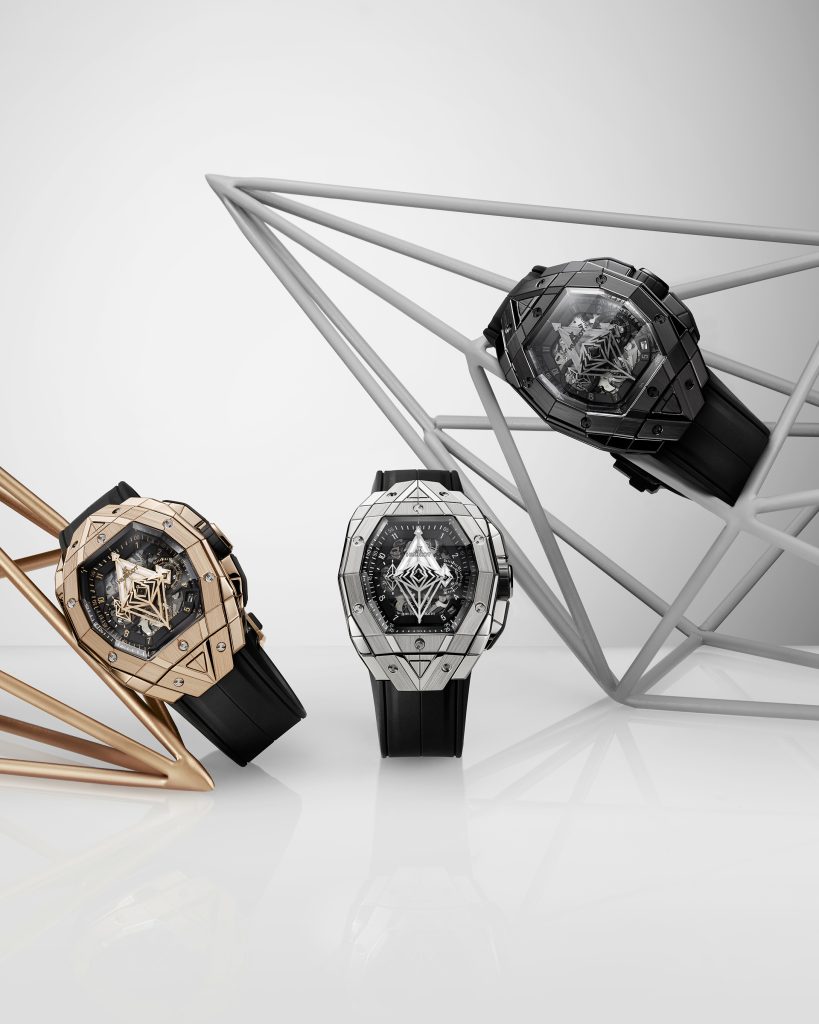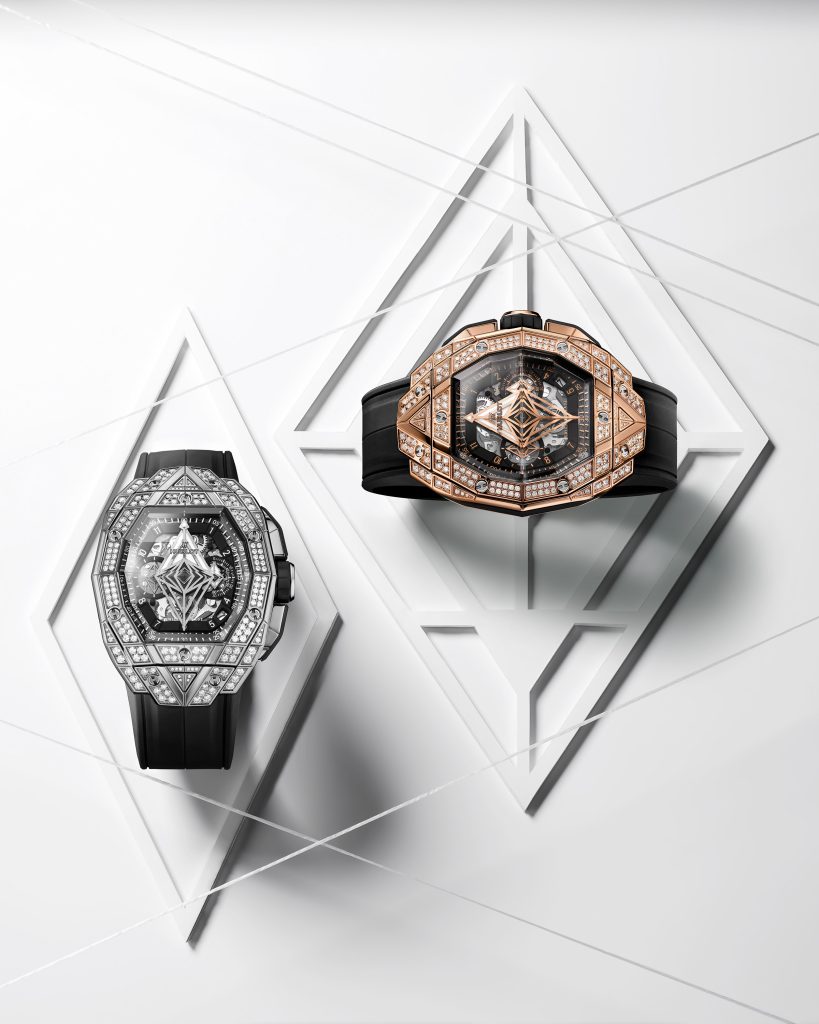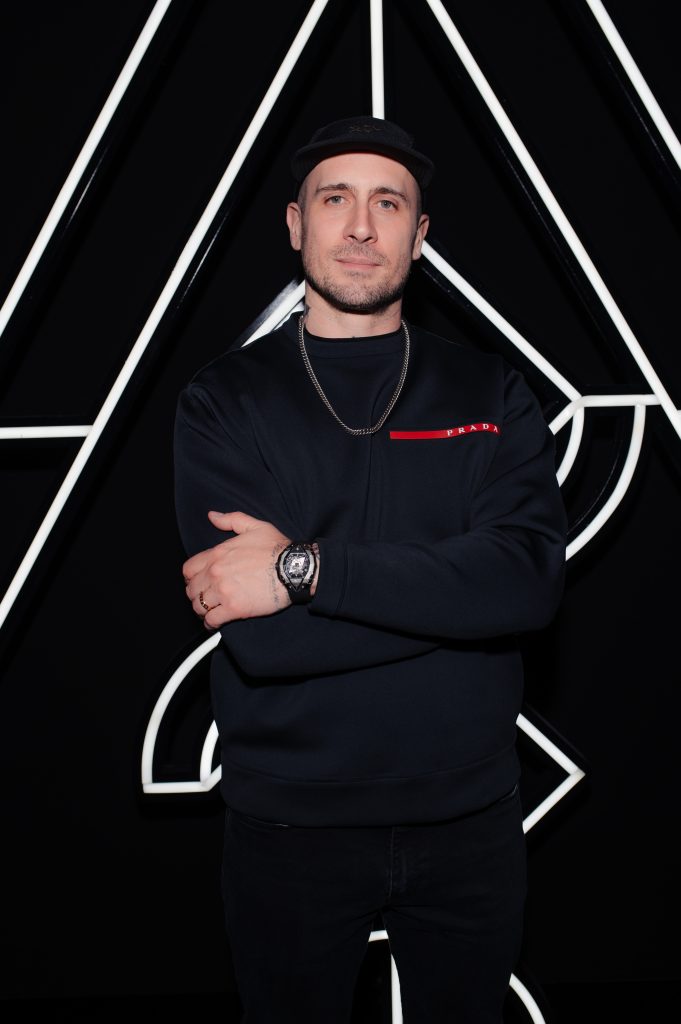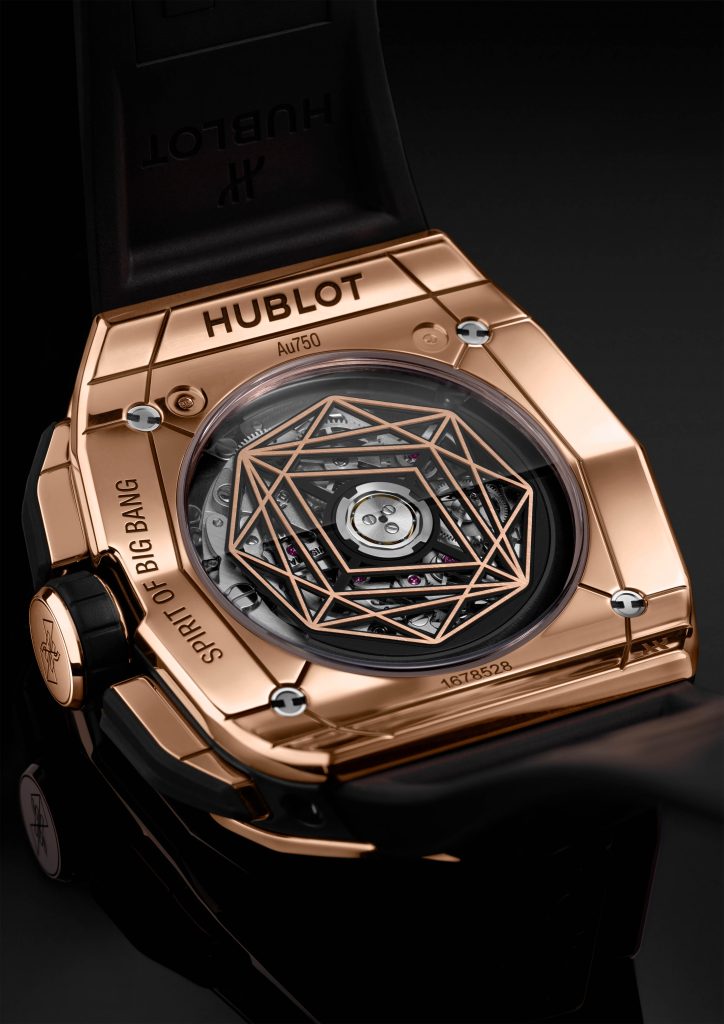
There’s a Latin saying: “Omne trium perfectum”, or “everything that comes in threes is perfect”. If it’s anything to go by, it almost guarantees the third edition of the collaboration between Hublot and Sang Bleu to be a roaring success. Unveiled at the Salone del Mobile in Milan this April, the Spirit of Big Bang Sang Bleu succeeds the Big Bang Sang Bleu I and II and continues the geometry-dominated narrative set in motion in 2016, by reinterpreting Hublot’s Spirit of Big Bang through Sang Bleu’s inimitable style.
This third act is conceptualised once again with Sang Bleu, the design studio and brand consultancy founded and led by designer, tattoo artist and Hublot ambassador Maxime Plescia-Büchi. It makes quite the first impression: Striking angularity, soaring lines and ordered symmetry, coupled with a bevelled, faceted expression and the interplay between relief and depth, create dramatic dimensionality. What’s more, instead of conventional hands, discs that hover above the sapphire dial serve as hour and minute markers.

The Spirit of Big Bang Sang Bleu comes in three limited editions: 200 units in titanium, 200 in black ceramic, and 100 in Hublot’s proprietary King Gold alloy, as well as two models, in titanium or King Gold, set with 180 diamonds apiece. Within the 42mm case sits the HUB4700 self-winding skeleton chronograph movement, offering a power reserve of 50 hours.
“I wanted the watch to feel like…an extension of the wearer”
With two Sang Bleu editions based on the Big Bang, the Spirit of Big Bang—a collection Hublot debuted in 2014 that has grown to become a pillar of the brand—was a natural candidate when planning for the third one began, according to Hublot CEO Ricardo Guadalupe. “Through discussing with Maxime, he thought that he could express himself and his graphic art through the Spirit of Big Bang, and the idea is always to have something very different from the previous edition,” he adds.

Meanwhile, Plescia-Büchi relished designing a barrel-shaped timepiece, which sits in between the Big Bang and the silhouette of a certain popular smartwatch. “I feel that the arrival of smartwatches gave a completely new relevancy to the rectangular shape in general,” he says. “If you think that now the gateway to watch owning is smartwatches and most of them are rectangular, that is the new normal, and a drastic change in the way to approach watch aesthetics and watch design.”



Read More: Hublot’s Watches Define Material Innovation
To Plescia-Büchi, the Spirit of Big Bang Sang Bleu is more an evolution of its predecessors than a new creation. “Each watch is like a snapshot of a moment, a progression in the continuous reflection,” he shares. “[Going from the first edition to the third], you can almost see the design go from sitting on top, to progressively spreading inside the watch and taking over it, and appropriating each aspect of the watch more deeply.”
And even with its generous proportions, the Spirit of Big Bang Sang Bleu still wears comfortably flush even for smaller wrists, owing to the thoughtful curvature in the back of the case and the sapphire crystal. “A pragmatic [consideration] was to ensure that we would keep the Hublot sports watch identity while making it very wearable,” Plescia-Büchi continues. “I wanted the watch to feel like it’s something that you miss if you don’t put it on in the morning…an extension of the wearer.”
There is no escaping the distinctive angularity of the Spirit of Big Bang Sang Bleu and recognising its connection to the polygonal leitmotif that frequently appears in the tattoo work that Plescia-Büchi exhibits on his Instagram account @mxmttt. “It’s a theme in my work because it’s a theme in human culture as a whole—geometry is the visual expression of mathematics, and mathematics is the expression of the abstraction of how human perception works, and the way we interact with the world. So, ultimately, geometry has this universal quality to it, and you find elements of it in absolutely every culture,” he explains. “I make sure to avoid things that are too unique or specific, so I don’t put symbols…It’s done so that people can see what they want to see in it.”
While that design approach may turn time-telling into a more involved process, the visual payoff makes up for it in spades. “It’s not easy to read the time, but as we say in the mechanical watchmaking industry, time is not essential,” comments Guadalupe, referring to the superior accuracy of an electronic watch or mobile phone. “Here, we have displayed time through the graphic of a tattoo, and I think that’s interesting as well, because the idea of Hublot is to try to reinterpret the mechanics of the movement.”
Through seven years spent designing three editions of Sang Bleu watches with Hublot, the collaboration has influenced Plescia-Büchi’s own design process, he shares. “Getting used to and learning to build something with a group of people with competencies that I don’t directly have and thinking with their competencies is a very interesting learning curve,” he says. “The experience working with Hublot really taught me that, and it’s something that I apply now on a daily basis.”

For Guadalupe, the project has assuaged any worries he had had about its longevity or success. “The first [edition] was a big challenge because even for me, I was thinking maybe it would not work, because it was a risk that we have taken and to be inspired by a tattoo artist,” he explains. “I would say I’ve been positively surprised, and it has inspired me to go further in that direction of having partnerships with artists in different types of art, but art that you can [translate] into a watch.”

“It has been a key element of the development of our partnership and really makes our brand unique. And I’ve seen now some other brands are [building] art partnerships, which is good, [because it’s] showing that the watch is a piece of art, in the end.”
Read More: Hublot Honours The Matterhorn With The New Big Bang Zermatt Watch
